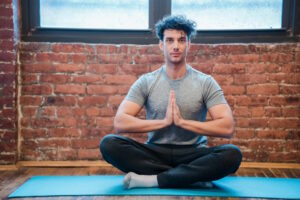
Mindful Pilates for beginners provides a gentle and accessible entry point into the world of Pilates, emphasizing both physical and mental well-being. Pilates, a mind-body exercise system developed by Joseph Pilates, focuses on core strength, flexibility, and overall body awareness. This guide aims to demystify Pilates for beginners, offering insights into which Pilates approach is best for newcomers, how often beginners should engage in Pilates sessions, the feasibility of starting Pilates with no prior experience, and practical tips for initiating a Pilates practice at home.
Which Pilates is best for beginners?
When starting your Pilates journey as a beginner, it’s advisable to begin with the following approaches:
1. Mat Pilates: Mat Pilates is an excellent starting point for beginners. It involves performing Pilates exercises on a padded mat, which provides support and comfort. Mat Pilates focuses on core strength, flexibility, and body awareness, making it an ideal choice for newcomers to build a solid foundation.
2. Classical Pilates: Classical Pilates is based on the original teachings of Joseph Pilates and follows a structured and progressive approach. It can be suitable for beginners who prefer a systematic and traditional approach to Pilates. Look for classes labeled as “beginner” or “introductory” to ensure a suitable starting point.
3. Contemporary Pilates: Contemporary Pilates incorporates elements of the original Pilates method but may introduce modifications and variations. It often caters to a broader audience, including beginners. Seek out contemporary Pilates classes designed for newcomers or those with limited experience.
4. Private Sessions: Private Pilates sessions with a certified instructor can be highly beneficial for beginners. They offer personalized guidance, ensuring that exercises are tailored to your individual needs and abilities.
Ultimately, the best Pilates approach for beginners may vary depending on individual preferences, goals, and physical condition. It’s essential to choose an approach that aligns with your comfort level and provides appropriate guidance and instruction.
How often should a beginner go to Pilates?
For beginners, the frequency of Pilates sessions can depend on various factors, including fitness goals, schedule, and individual preferences. Here are some general recommendations:
· 1-2 Times a Week: Starting with one or two Pilates sessions per week can be a suitable frequency for beginners. This allows you to gradually build strength, flexibility, and body awareness while accommodating your schedule.
· Consistency: Consistency is key in Pilates. It’s often more beneficial to attend regular, consistent sessions than to cram multiple sessions into a short timeframe. Pilates is about gradual progress and mindful practice.
· Listen to Your Body: Pay attention to your body’s signals. If you feel fatigued or sore, allow adequate time for recovery between sessions. Overexertion can lead to injury and hinder progress.
· Variety: Consider incorporating a mix of mat Pilates and equipment-based Pilates (if available) to provide variety and stimulate different muscle groups.
· Progression: As you become more experienced and conditioned, you may choose to increase the frequency of your sessions to meet your evolving goals.
Can you start Pilates as a beginner?
Absolutely, Pilates is suitable for beginners of all ages and fitness levels. In fact, Pilates is renowned for its adaptability and can be tailored to accommodate individuals with no prior experience. Many Pilates classes offer beginner-level sessions, and certified instructors are trained to provide modifications and adjustments to meet the needs of newcomers.
Starting Pilates as a beginner is a great way to build a strong foundation in core strength, flexibility, and body awareness. It’s essential to communicate your beginner status to your instructor, as they can provide guidance, ensure proper form, and offer variations that match your skill level.
How do I start Pilates at home for beginners?
Starting Pilates at home as a beginner is both convenient and accessible. Here’s a step-by-step guide to help you begin your Pilates journey from the comfort of your home:
1. Set Up a Comfortable Space: Choose a quiet and clutter-free area with enough room to perform Pilates exercises comfortably. You’ll need a padded exercise mat for floor exercises.
2. Access Online Resources: There are numerous online platforms and videos that offer beginner-friendly Pilates workouts. Look for reputable instructors or studios that provide guided sessions specifically designed for beginners.
3. Start with Basic Exercises: Begin with foundational exercises that focus on core strength and body awareness. Exercises like the Pilates Hundred, Single Leg Stretch, and The Saw are excellent starting points.
4. Focus on Proper Form: Pay close attention to your form and alignment during each exercise. Proper alignment is essential for safety and effectiveness.
5. Practice Mindfulness: Embrace the mindfulness aspect of Pilates by being fully present in your practice. Focus on your breath, body sensations, and the quality of your movements.
6. Gradual Progression: As you become more comfortable with beginner-level exercises, consider exploring more advanced Pilates routines. However, always prioritize safety and gradual progression.
7. Stay Consistent: Consistency is key in Pilates. Aim to practice regularly, whether it’s a few times a week or daily, to experience the full benefits of the practice.
Summarizing Mindful Pilates for Beginners
In summary, Pilates is an excellent choice for beginners seeking to enhance their physical fitness and mental well-being. Starting with mat Pilates or introductory classes, beginners can gradually build core strength, flexibility, and body awareness. The frequency of Pilates sessions should align with individual goals and comfort levels, with a focus on consistency and progression. Pilates is inclusive and adaptable, making it suitable for individuals of all experience levels. Starting Pilates at home is also a viable option, provided you create a conducive space and access reputable online resources. Ultimately, Pilates for beginners is a journey of self-discovery and holistic well-being that can be tailored to individual needs and preferences.